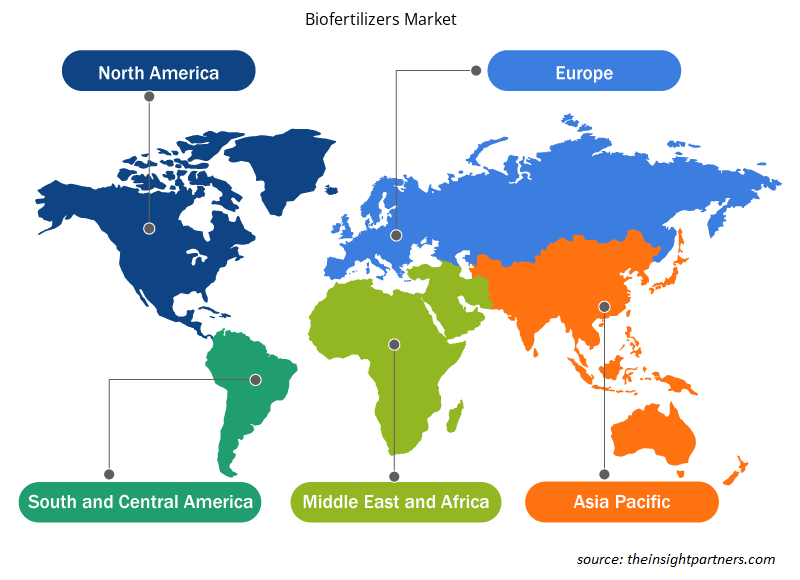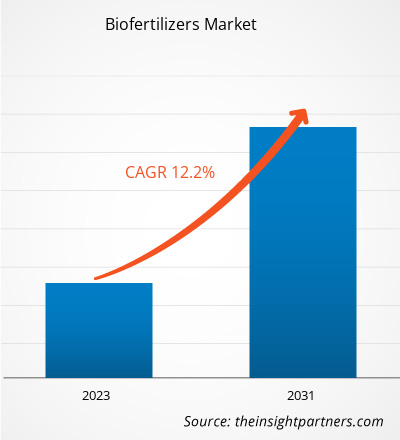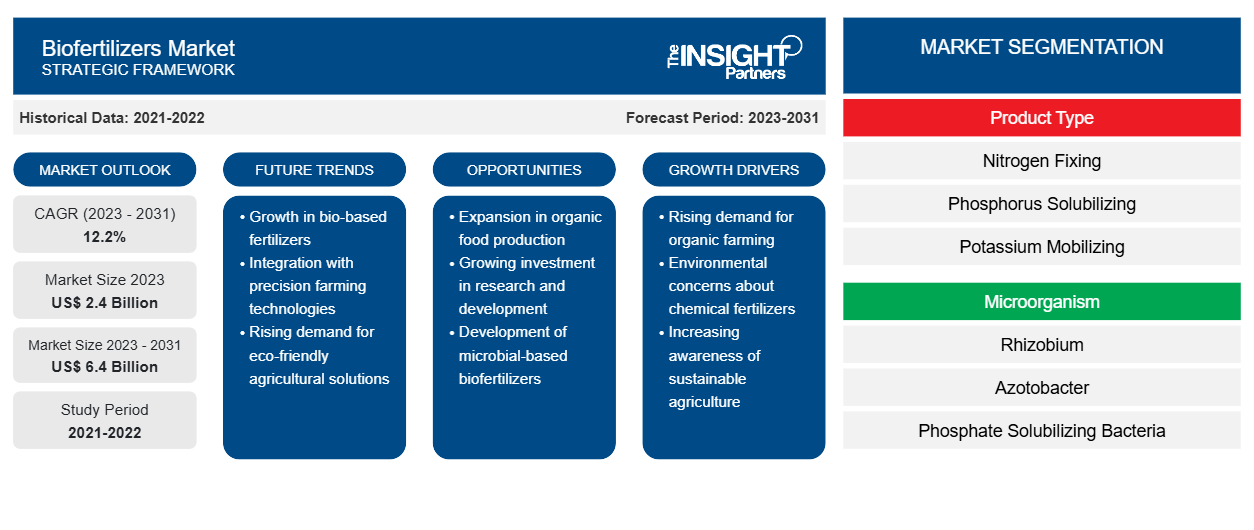Se proyecta que el tamaño del mercado de biofertilizantes alcance los 6.400 millones de dólares estadounidenses en 2031, frente a los 2.400 millones de dólares estadounidenses en 2023. Se espera que el mercado registre una CAGR del 12,2 % durante el período 2023-2031. Es probable que el creciente enfoque de las empresas manufactureras en la innovación y en el suministro de nuevos productos para mejorar la experiencia del cliente siga siendo una tendencia clave en el mercado de biofertilizantes.
Análisis del mercado de biofertilizantes
El método de agricultura orgánica incluye el crecimiento y el cuidado de los cultivos con la utilización de materiales biológicos eliminando el uso de fertilizantes sintéticos. La agricultura orgánica se está adoptando cada vez más para lograr productos alimenticios saludables y de alta calidad . Junto con esto, la agricultura orgánica proporciona varios beneficios ambientales; por ejemplo, mejora la fertilidad del suelo, ayuda a combatir la erosión del suelo y reduce las emisiones de gases de efecto invernadero. El biofertilizante es uno de los componentes esenciales de las prácticas de agricultura orgánica porque combina microorganismos naturales con fertilizantes ricos en nutrientes de origen orgánico que proporcionan un entorno de crecimiento saludable para las plantas y los suelos. Los biofertilizantes también ayudan a mejorar la resistencia de la planta contra las plagas y los factores estresantes abióticos como la sequía, el exceso de agua y los cambios extremos de temperatura. Por lo tanto, el rápido crecimiento de la agricultura orgánica debido a la mayor adopción de productos orgánicos por parte de los consumidores de todo el mundo está impulsando el crecimiento del mercado de biofertilizantes.
Panorama del mercado de biofertilizantes
Los biofertilizantes están compuestos por microbios y bacterias vivas que promueven la fertilidad del suelo y el crecimiento de las plantas. Estos microbios apoyan el proceso de fijación de nitrógeno para producir los componentes esenciales para el crecimiento de la planta. Los biofertilizantes son bien conocidos por su relación costo-beneficio y su naturaleza respetuosa con el medio ambiente. El mercado de biofertilizantes está experimentando una gran demanda debido a un cambio de tendencia hacia la agricultura sostenible . El creciente interés y el apoyo gubernamental en la agricultura orgánica ha provocado un auge en la industria de los biofertilizantes. Por lo tanto, se espera que el mercado de biofertilizantes impulse su crecimiento durante el período de pronóstico.
Personalice este informe según sus necesidades
Obtendrá personalización en cualquier informe, sin cargo, incluidas partes de este informe o análisis a nivel de país, paquete de datos de Excel, así como también grandes ofertas y descuentos para empresas emergentes y universidades.
-
Obtenga las principales tendencias clave del mercado de este informe.Esta muestra GRATUITA incluirá análisis de datos, desde tendencias del mercado hasta estimaciones y pronósticos.
Factores impulsores y oportunidades del mercado de biofertilizantes
Iniciativas gubernamentales en aumento y mayor conciencia sobre técnicas agrícolas sostenibles
Los gobiernos de varios países están tomando iniciativas para impulsar la adopción de biofertilizantes. Por ejemplo, en la India, varios gobiernos estatales han apoyado el uso de biofertilizantes en lugar de fertilizantes químicos o sintéticos a través de programas o esquemas como “Paramparagat Krishi Vikas Yojana (PKVY)” y “Mission Organic Value Chain Development for Northeastern Region (MOVCDNER)”. Además, la “Política Agrícola Común” de la Unión Europea (UE) tiene como objetivo promover el uso de recursos biológicos en toda la región. Por lo tanto, las iniciativas gubernamentales, junto con la creciente inclinación hacia la sostenibilidad en la agricultura moderna, impulsan la demanda de biofertilizantes en todo el mundo.biofertilizers. For instance, in India, various state governments have been supporting the use of biofertilizers over chemical or synthetic fertilizers through programs or schemes such as “Paramparagat Krishi Vikas Yojana (PKVY)” and “Mission Organic Value Chain Development for Northeastern Region (MOVCDNER).” Further, the “Common Agricultural Policy” by the European Union (EU) aims to promote the use of biological resources across the region. Thus, government initiatives, along with the increased inclination toward sustainability in modern agriculture, trigger the demand for biofertilizers across the world.
Aumento de la producción y el rendimiento de los cultivos
La aplicación de biofertilizantes es una de las tecnologías potenciales para los sistemas agrícolas sostenibles. Los agricultores están utilizando ampliamente biofertilizantes fijadores de nitrógeno y solubilizadores de fosfato para producir cultivos de alta demanda, como el trigo, las semillas oleaginosas y el arroz. Por lo tanto, se incluyen diferentes microorganismos en los biofertilizantes para ayudar a aumentar la producción y el rendimiento de los cultivos, lo que brinda diversas oportunidades de crecimiento para el mercado de biofertilizantes en todo el mundo.biofertilizers is one of the potential technologies for sustainable farming systems. Famers are widely using nitrogen-fixing phosphate solubilizing bio-fertilizers to produce high-demand crops such as wheat, oilseeds, and rice. Thus, different microorganisms are included in biofertilizers to help increase the production and yield of crops, thereby providing various growth opportunities for the biofertilizers market across the world.
Análisis de segmentación del informe de mercado de biofertilizantes Market Report Segmentation Analysis
Los segmentos clave que contribuyeron a la derivación del análisis del mercado de biofertilizantes son el tipo de producto, el microorganismo, el tipo de cultivo y la aplicación.Biofertilizers Market analysis are product type, microorganism, crop type, and application.
- Según el tipo de producto, el mercado de biofertilizantes se divide en fijadores de nitrógeno, solubilizadores de fósforo, movilizadores de potasio y otros. El segmento de fijación de nitrógeno tuvo la mayor participación de mercado en 2023.biofertilizers market is divided into nitrogen fixing, phosphorus solubilizing, potassium mobilizing, and others. The nitrogen fixing segment held the largest market share in 2023.
- Por microorganismo, el mercado se segmenta en rizobios, azotobacter, bacterias solubilizadoras de fosfato y otros. El segmento de rizobios tuvo la mayor participación del mercado en 2023.rhizobium, azotobacter, phosphate solubilizing bacteria, and others. The rhizobium segment held the largest share of the market in 2023.
- En términos de tipo de cultivo, el mercado se divide en cereales y granos, semillas oleaginosas y legumbres, frutas y verduras, entre otros. El segmento de cereales y granos dominó el mercado en 2023.
- Por aplicación, el mercado se divide en tratamiento de semillas, tratamiento del suelo y otros. El segmento de tratamiento de semillas dominó el mercado en 2023.
Análisis de la cuota de mercado de los biofertilizantes por geografía Market Share Analysis by Geography
El alcance geográfico del informe del mercado de biofertilizantes se divide principalmente en cinco regiones: América del Norte, Asia Pacífico, Europa, Medio Oriente y África, y América del Sur / América del Sur y Central.
América del Norte ha dominado el mercado de biofertilizantes. América del Norte es una de las regiones más importantes para el mercado de biofertilizantes debido al creciente consumo de alimentos orgánicos y libres de químicos en toda la región. Además, Estados Unidos se encuentra entre los productores más importantes de biofertilizantes en todo el mundo; aunque los fertilizantes químicos no suelen etiquetarse como "saludables", los consumidores buscan alternativas más saludables como los biofertilizantes. Uno de los impulsores del mercado, según el DOE y el USDA, es la abundante oferta de materias primas de biomasa. Estos son algunos de los factores que impulsan la demanda de biofertilizantes en los países de América del Norte. Se prevé que Asia Pacífico crezca con la CAGR más alta en los próximos años.biofertilizers market. North America is one of the prominent regions for the biofertilizers market owing to the increasing consumption of chemical-free and organic food across the region. Moreover, the US is among the significant producers of biofertilizers around the world; although chemical fertilizers are not usually labelled ‘healthy,’ consumers look for healthier alternatives such as biofertilizers. One of the market drivers, according to DOE and USDA, is the abundant supply of biomass raw materials. These are some of the factors boosting the demand for biofertilizers in the North American countries. Asia Pacific is anticipated to grow with the highest CAGR in the coming years.
Perspectivas regionales del mercado de biofertilizantes
Los analistas de Insight Partners explicaron en detalle las tendencias y los factores regionales que influyen en el mercado de biofertilizantes durante el período de pronóstico. Esta sección también analiza los segmentos y la geografía del mercado de biofertilizantes en América del Norte, Europa, Asia Pacífico, Medio Oriente y África, y América del Sur y Central.

- Obtenga los datos regionales específicos para el mercado de biofertilizantes
Alcance del informe de mercado de biofertilizantes
| Atributo del informe | Detalles |
|---|---|
| Tamaño del mercado en 2023 | 2.400 millones de dólares estadounidenses |
| Tamaño del mercado en 2031 | 6.4 mil millones de dólares estadounidenses |
| CAGR global (2023 - 2031) | 12,2% |
| Datos históricos | 2021-2022 |
| Período de pronóstico | 2023-2031 |
| Segmentos cubiertos |
Por tipo de producto
|
| Regiones y países cubiertos |
América del norte
|
| Líderes del mercado y perfiles de empresas clave |
|
Densidad de actores del mercado de biofertilizantes: comprensión de su impacto en la dinámica empresarial
El mercado de biofertilizantes está creciendo rápidamente, impulsado por la creciente demanda de los usuarios finales debido a factores como la evolución de las preferencias de los consumidores, los avances tecnológicos y una mayor conciencia de los beneficios del producto. A medida que aumenta la demanda, las empresas amplían sus ofertas, innovan para satisfacer las necesidades de los consumidores y aprovechan las tendencias emergentes, lo que impulsa aún más el crecimiento del mercado.
La densidad de actores del mercado se refiere a la distribución de las empresas o firmas que operan dentro de un mercado o industria en particular. Indica cuántos competidores (actores del mercado) están presentes en un espacio de mercado determinado en relación con su tamaño o valor total de mercado.
Las principales empresas que operan en el mercado de biofertilizantes son:
- Vida agrícola
- Biotecnología Internacional Ltd.
- Corporación del grupo de productos biotecnológicos Kiwa
- Empresa Agri Biotec Ltda.
- Novozimas
- RIZOBÁCTER
Descargo de responsabilidad : Las empresas enumeradas anteriormente no están clasificadas en ningún orden particular.

- Obtenga una descripción general de los principales actores clave del mercado de biofertilizantes
Noticias y desarrollos recientes del mercado de biofertilizantes
El mercado de los biofertilizantes se evalúa mediante la recopilación de datos cualitativos y cuantitativos posteriores a la investigación primaria y secundaria, que incluye publicaciones corporativas importantes, datos de asociaciones y bases de datos. A continuación, se incluye una lista de los avances en el mercado de los trastornos del habla y el lenguaje:
- Syngenta Biologicals y Unium Bioscience anuncian una colaboración para ofrecer innovadoras soluciones biológicas de tratamiento de semillas basadas en NUELLO® iN a los agricultores del noroeste de Europa. (Fuente: Syngenta, Newsletter, 2023)
- Performance Nutrition presentó su marca NutriWise, un fertilizante granulado y en polvo soluble en agua que reemplazará a la antigua línea de productos NutriSmart. Los nuevos productos están disponibles para los mercados agrícola, de césped y ornamental. (Fuente: LidoChem, Inc., comunicado de prensa, 2022)
Informe sobre el mercado de biofertilizantes: cobertura y resultados
El informe “Tamaño y pronóstico del mercado de biofertilizantes (2021-2031)” proporciona un análisis detallado del mercado que cubre las siguientes áreas:
- Tamaño del mercado y pronóstico a nivel global, regional y nacional para todos los segmentos clave del mercado cubiertos bajo el alcance
- Dinámica del mercado, como impulsores, restricciones y oportunidades clave
- Principales tendencias futuras
- Análisis detallado de las cinco fuerzas de Porter y PEST y FODA
- Análisis del mercado global y regional que cubre las tendencias clave del mercado, los principales actores, las regulaciones y los desarrollos recientes del mercado.
- Análisis del panorama de la industria y de la competencia que abarca la concentración del mercado, el análisis de mapas de calor, los actores destacados y los desarrollos recientes
- Perfiles detallados de empresas
- Análisis histórico (2 años), año base, pronóstico (7 años) con CAGR
- Análisis PEST y FODA
- Tamaño del mercado, valor/volumen: global, regional y nacional
- Industria y panorama competitivo
- Conjunto de datos de Excel
Informes recientes
Informes relacionados
Testimonios
Razón para comprar
- Toma de decisiones informada
- Comprensión de la dinámica del mercado
- Análisis competitivo
- Información sobre clientes
- Pronósticos del mercado
- Mitigación de riesgos
- Planificación estratégica
- Justificación de la inversión
- Identificación de mercados emergentes
- Mejora de las estrategias de marketing
- Impulso de la eficiencia operativa
- Alineación con las tendencias regulatorias























 Obtenga una muestra gratuita para - Mercado de biofertilizantes
Obtenga una muestra gratuita para - Mercado de biofertilizantes